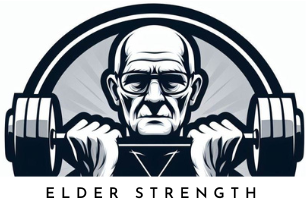Hello friend! Welcome to ElderStrength.com. In this post, you will learn about pull-ups for seniors. Are they beneficial, are they safe and can seniors do them?
The pull-up, alongside the push-up, pull-ups are probably the most recognized strength training exercises.
Everyone has at least a vague idea of how they are performed and most people have performed them in school, in occupational physical tests, or in the military. And of course for improving their fitness.
But the thing about pull-ups is that they are demanding. Actually very demanding by modern standards.
In the old days, at least most of the boys and many of the girls could perform at least a couple of pull-ups in school tests.
Unfortunately, physical fitness has plummeted and average body weight has increased in the past decades among all age groups due to our sedentary way of life and abundance of food.
Since a pull-up is dependent on your upper body strength relative to your body weight, fewer and fewer people are able to perform them these days.
On the other hand, this makes pull-ups a great test for physical performance. If you can do several pull-ups with a full range of motion, your physical fitness will likely be very good.
So the question is, are pull-ups good for seniors, and are there special considerations for seniors? Read on to find out.
What Is A Pull-Up
Pull-up is an upper body strength training exercise that involves mainly the upper back musculature and the biceps.
Pull-ups and it’s variations are one of the main exercises in calisthenics and bodyweight training and are often used by strength athletes, bodybuilders, and gymnasts to build upper body pulling strength and muscle mass.
Besides using the back and biceps, the pull-up will activate most of the upper body musculature for stabilization and it’s a very functional movement.
Pull-ups are essential for any kind of climbing activity since climbing involves a lot of pulling yourself up, often mostly with your upper body.
But the real magic of the pull-up is in its simplicity and effectiveness. All you need is a bar or a sturdy branch to hang on and you can train half of your upper body.
You could actually train your whole body simply by doing pull-ups, push-ups, and bodyweight squats or lunges. This is more than enough for general health.
The pull-up is also a very functional and intuitive movement. Performing it will make all kinds of pulling movements easier to do.
Pull-up is also demanding enough to be a good strength exercise, you are lifting virtually your whole body weight after all.
Typically people can perform a few pull-ups but even most athletes can perform less than 20-30 pull-ups, so it falls in the range where strength and muscle adaptation happen readily.
How It’s Performed
The “official” way to do a pull-up is to hang on a bar with palms facing away from your arms fully extended. In a pull-up, you will typically have your hands a bit wider than shoulder-width.
You then pull yourself up, keeping your core and legs straight (no kicking or kipping!) until your chin is above the bar. If you are very strong, you can pull the bar all the way to your chest.
There are some common variations of pull-ups, the most known being the chin-up. The chin-up is performed in a similar fashion but with your palms facing towards you and with a slightly narrower grip.
Chin-ups involve a bit more bicep activation but they are very similar movements and in my opinion, any kind of pull is fine. I personally find chin-ups with narrow grip easier on the shoulders.
Common mistakes with performing pull-ups are using a reduced range of motion, kicking and yanking your legs, and bouncing from the bottom. These are all due to a lack of strength.
It’s better to perform pull-ups in a controlled manner, where your arms and back are doing all the work. Yes, this is harder, but it’s safer and more effective.
If you can’t perform a pull-up with a good technique, it’s better to build up your strength with alternative movements than risk injury with questionable form.
Pull-Ups For Seniors
So are pull-ups suitable for seniors? Well yes and no.
Pull-ups are great for keeping up your upper body strength IF you can perform them with proper form without over-exerting yourself.
Unfortunately, this is a very small percentage of seniors. Typically if you are fit enough to perform several full-range pull-ups as a senior, you’ve probably been doing some form of strength training your whole life.
Pull-ups require a loth strength which means there is a lot of force transferred through your muscles and connective tissue.
Pull-ups also require a lot of mobility from your shoulder joints and upper body musculature to be performed with a full range of motion.
There is a very real possibility of injury with pull-ups for seniors that are not accustomed to them. Performing them with a reduced range of motion just increases injury risk.
Anything from pulling your upper back to tearing a bicep or getting ligament injuries is possible if you try to perform pull-ups.
Unfortunately, there are a lot of older guys who haven’t done strength training in years but think they still have the strength and durability of their younger selves.
When they decide to get in shape they just hop on the bar and start yanking, which can end very badly. Don’t be that guy (or gal).
For those reasons you should really consider if pull-ups are suitable for you. If you are experienced in strength training or calisthenics and have done pull-ups in recent years, it’s probably enough to listen to your body, you will know your limits.
Just beware the pull-ups can be demanding on the shoulder and elbow joints in the long run, so
But if you are untrained, overweight, or lack mobility and strength pull-ups are not a good idea as a senior.
What To Do Instead Of Pull-Ups For Seniors
So if you can’t perform pull-ups, how can you train your upper body? Fortunately, there are a lot of solutions.
If you are going to a gym, any kind of rowing exercise is a good substitute for pull-ups. Rows can be performed with dumbbells, barbells, or machines with reduced weight compared to pull-ups.
Lat pulldowns are a direct substitute for pull-ups as they involve a vertical pulling motion. They are also great for building up strength if you eventually want to progress to pull-ups.
Just beware that there is no need to aim for that high weight as a senior for health reasons. The injury risk increases with heavier weights after all so train smart.
At home, you can use resistance bands, dumbbells, or kettlebells to perform row variations.
Dumbbells and kettlebells are great for single-hand rows and resistance bands can be used to do vertical rows if you have something to the band on.
For health effects and overall well-being, it doesn’t really matter if you perform vertical or horizontal rows, but it’s a good idea to change between them from time to time if possible.
Conclusion
That’s it for the pull-ups for seniors. I hope you found the post useful and answered some questions for you. I’m looking forward to your feedback and thought on the comments section below.
As a recap, the pull-up and its variations are a great strength training exercise for the upper back and biceps but due to its high strength demands and thus injury risk, it’s not suitable for most seniors.
Fortunately, it’s possible to do strength training for your upper back and biceps by performing different kinds of rowing or pulling exercises with machines, free weights, and exercise bands.
A strong upper back is good for posture and functional day-to-day strength, to make to include some form of rowing or pulling exercise in your exercise routine.
Thanks for reading and see you next time!

